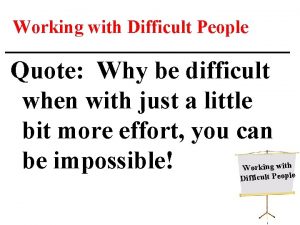Session 10 Communicating Difficult Decisions People Skills PS










- Slides: 10

Session 10 Communicating Difficult Decisions People Skills (PS 10 -01) Accredited By: Copyright © 2010 by The Association of Business Practitioners

Communicating Difficult Decisions • • In the current difficult economic climate, making redundancies and announcing job-losses continues to be a difficult and unpopular management decision. You might have a personal experience with, or at least known of pay freezes, reduced hours in which you are expected to do the same amount of work, or had friends and relatives that have been made redundant. Difficult decisions do not get easier once they have been made. Suspicion and intrigue always seem to surround any difficult decisions that have had to be made. In this section, we will look at the different ways in which the employers use various means of communication to put across difficult decisions. Session 1: Customer Service (CS 10 -01) © BBPSD 2010, All Rights Reserved 2

Communicating Difficult Decisions How bad news is being delivered? Research shows that bad news is delivered mainly by email. The complete list is: – – – – 29% - By an e-mail message. 19% - In face-to-face meetings with direct supervisors. 18% - In face-to-face meetings with senior managers. 12% - By Letter or memo from senior managers. 8% - Using the internal employee website. 6% - Via Teleconference or videoconference. 3. 5% - In an organisation newsletter. [Examination Hint] Session 1: Customer Service (CS 10 -01) © BBPSD 2010, All Rights Reserved 3

Communicating Difficult Decisions Activity 1. What has been one of your most difficult decisions to make and communicate in the workplace? 2. What did you do? 3. Why you chose to do what you did? 4. Could you have done it a different way? Session 1: Customer Service (CS 10 -01) © BBPSD 2010, All Rights Reserved 4

Communicating Difficult Decisions The ‘CAGE’ approach One way of remembering how to get communication correct is to use the CAGE approach. • • Communicate to avoid any misunderstandings. Answer all the queries and questions. Don’t let the other person go with any doubts. Get your act together. Be conversant with the facts of the case and details behind the issue. Explain the details. Don’t assume the other person has understood you completely. Be explicit. Session 1: Customer Service (CS 10 -01) © BBPSD 2010, All Rights Reserved 5

Communicating Difficult Decisions Some Tips when delivering bad news • • Whenever people receive negative information, there is a tendency to go into a selective listening mode. This means you will need to choose your words carefully so your message will be understood. Be empathetic, but do not say things like "I know how you feel, " "I wish I didn’t have to do this, " or "This isn’t my decision" because if you’re delivering the bad news, you’re accountable and need to support the decision of management. Plan your meeting. Write down what you intend to say to make sure you cover all the key points. Always be firm, polite and professional and you will be able to get the right message across’. Session 1: Customer Service (CS 10 -01) © BBPSD 2010, All Rights Reserved 6

Communicating Difficult Decisions Example You are the Head Teacher of a school in Scotland. It is February, cold and wintery and it has been snowing for the past 20 hours. There is some debate during the staff tea break whether to go ahead with the school educational trip to London which was planned a few months before and the children are quite excited about. Some parents have also met you this morning to express their last minute concern. You however decide to go ahead with the trip. After an hour, you receive a phone call from the police that the school bus collided with another lorry and met with an accident. There seem to be a few casualties. Activity How do you analyse the decision to go ahead with the trip and more so, how would you communicate this difficult news? Session 1: Customer Service (CS 10 -01) © BBPSD 2010, All Rights Reserved 7

Communicating Difficult Decisions When delivering bad news, or passing on information that you know will not be well received, always do so face-to-face if you can. [Examination Hint] Example Think back to a recent public issue (Oil spill, floods, economic downturn, Tax rise, food shortage, etc. ). In all these case it is usual for the head of the organisation, or leading politician, to give out the bad news. In fact if there is a real issue and the leading person in charge is not seen in public apologising and saying what he is going to do about the problem, he will immediately face criticism. In general, people would rather hear bad news than be reliant on rumours and gossip. Session 1: Customer Service (CS 10 -01) © BBPSD 2010, All Rights Reserved 8

Communicating Difficult Decisions • • Several factors may serve as barriers to effectively communicating a difficult decision. These barriers can be divided into two classes: individual barriers and organisational barriers. Individual barriers can be the personal likes and dislikes of the people involved. A fear of being disliked. A fear of making a decision that will perhaps be found to be the wrong one in the future, etc. Organisational barriers can be the gap between top and middle level management, the centralised structures of the organisation, open plan offices which do not allow for private conversations, a lack of time in a busy day for proper communication to take place, etc. Session 1: Customer Service (CS 10 -01) © BBPSD 2010, All Rights Reserved 9

Summary • We all have to make some difficult decisions in our lives. • While such decisions are difficult to make, communicating such decisions might be more stressful. • Taking difficult decisions often involve uncertainties, complexities and a counter opinion which might not be easy to communicate. • You can use some of the tips mentioned to make this process much smoother. • Sometimes organisational barriers have to be overcome for effective communication of difficult decisions. Session 1: Customer Service (CS 10 -01) © BBPSD 2010, All Rights Reserved 10
 Communicating with difficult people
Communicating with difficult people Meaning of poster making
Meaning of poster making Silk glove sign procedure
Silk glove sign procedure Screening decisions and preference decisions
Screening decisions and preference decisions Observation is the basic skill for the scientific method
Observation is the basic skill for the scientific method Predicting science process skills
Predicting science process skills Leadership is communicating people's worth
Leadership is communicating people's worth Identifying toxic people
Identifying toxic people People with political savvy make decisions that
People with political savvy make decisions that Marketing real people real decisions
Marketing real people real decisions Marketers classify innovations based on their
Marketers classify innovations based on their


















